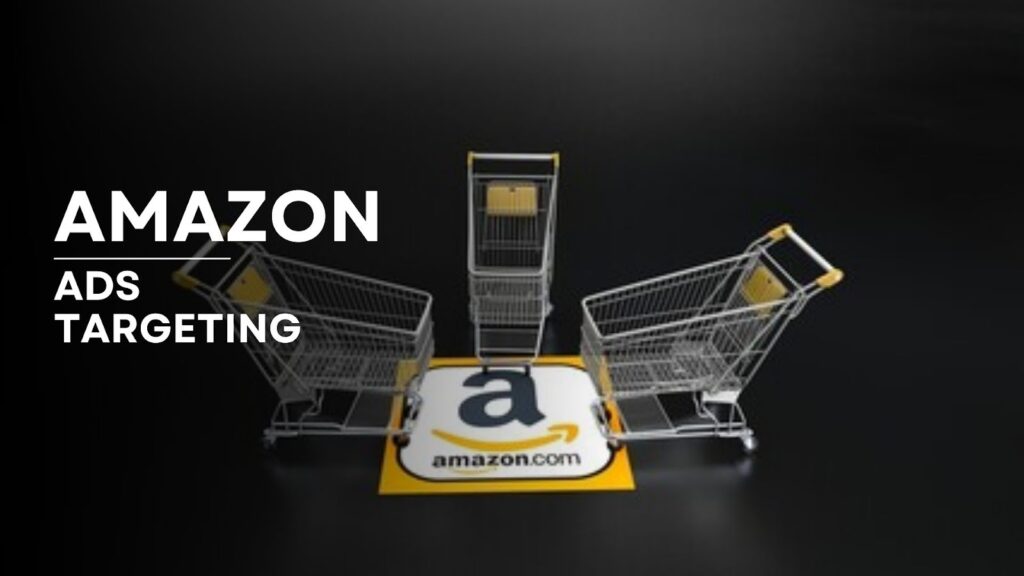What is Amazon Ads Targeting?
Did you know there are more than 9.7 million Amazon sellers globally?
This number highlights the importance of investing in Amazon ads. Advertisers considering Amazon ads should first familiarize themselves with Amazon ad targeting.
Amazon Ads Targeting refers to the strategies used in sponsored product campaigns to effectively reach potential customers. Sponsored Products are ads that promote individual product listings, appearing in search results and on product detail pages.
Advertisers can choose between:
- Automatic Targeting: Amazon decides which keywords to use based on the product information.
- Manual Targeting: Advertisers select specific keywords or product Amazon Standard Identification Numbers (ASINs) they want to target.
This flexibility allows brands to optimize their advertising efforts based on their goals and performance data.
Importance of Ads Targeting
Targeting is crucial in Amazon Ads because it directly influences ad visibility and conversion rates. By honing in on the right audience, brands can:
- Maximize ROI
- Enhance Relevance
- Improve Campaign Performance
Matching Shopper Intent with Products
Matching shopper intent with products is at the heart of effective targeting. Understanding what customers are searching for and what they intend to purchase enables you to tailor your campaigns more precisely. Key strategies include:
- Keyword Research: Identifying relevant keywords that shoppers are using can help align ads with their search queries, ensuring that the right products are showcased.
- Product Selection: By analyzing which products resonate most with certain keywords or audiences, you can choose to promote products that meet shopper demand.
- Audience Insights: Leveraging customer data, such as shopping behavior and preferences, helps refine targeting and deliver ads that cater to the specific needs and intents of different shopper segments.
Watch this video here to learn more about how to create product-targeting ads on Amazon
Types of Targeting Options
There are different types of targeting options in Amazon Ads, such as:
1. Automatic Targeting
Automatic targeting is a feature in Amazon Ads that simplifies the advertising process by allowing Amazon’s algorithms to select relevant keywords and match them with shopper searches. This option is particularly beneficial for advertisers who may not have extensive keyword research experience or who want to save time in setting up their campaigns. By using automatic targeting, brands can increase their visibility and gather valuable insights into customer behavior without manually managing every aspect of the campaign.
How It Works: Matching to Shopper Searches
Automatic targeting relies on Amazon’s advanced algorithms to analyze product listings, including:
- Titles
- Descriptions
- Other attributes
When a shopper enters a search query, Amazon identifies the most relevant products based on this analysis. The system then displays ads for those products, ensuring that they reach customers actively searching for related items.
This process is designed to match ads with intent, helping brands capture potential buyers at various stages of their shopping journey.
Four Automatic Targeting Strategies
When it comes to optimizing your Amazon ad placements, Maino’s Targeting feature can be a significant help. Furthermore, automatic targeting includes four specific strategies to optimize ad placements, such as
- Close Match: This strategy focuses on matching ads with search terms that are closely related to the product. It targets specific keywords that reflect the core attributes of the product, ensuring high relevance. For instance, a seller listing a fitness tracker could use close match targeting to show ads when customers search for terms like “fitness tracker” or “activity tracker.” The ad would appear for highly relevant and specific searches closely related to the product itself.
- Loose Match: Loose match broadens the search criteria, including related phrases and synonyms. This approach captures a wider audience but may result in less precise targeting compared to a close match. For example, a seller promoting a pair of running shoes might have ads displayed for broader search terms such as “athletic footwear” or “sports gear.” These ads would reach a wider audience but might not always align perfectly with the product’s core attributes.
- Substitutes: This strategy targets products that are similar and can serve as alternatives to the advertised product. Ads may appear alongside competitors’ products that shoppers are considering. For example, a seller offering a budget smartphone can target customers viewing more expensive smartphones. Ads for the budget smartphone will appear when shoppers are comparing alternatives, increasing the chances of converting customers looking for a similar yet more affordable option.
- Complements: Complement targeting showcases products that are frequently purchased together or the ones users have viewed on the Products Details Page (PDP) of the products. This strategy is useful for cross-selling and reaching customers looking for related items. For example, a seller listing a camera tripod might use complement targeting to display ads when customers search for cameras. Since tripods are often bought together with cameras, this strategy helps the seller cross-sell their product to an audience looking for related items.
Benefits of Automatic Targeting for Advertisers
Automatic targeting offers several advantages for advertisers, such as:
- It simplifies the campaign setup process, allowing advertisers to focus on other aspects of their marketing strategy.
- By covering a wide array of relevant search terms, automatic targeting helps brands reach more potential customers, even those they might not have considered.
- As the campaign runs, advertisers gain valuable data on which search terms are driving traffic and conversions, enabling them to refine their overall advertising strategy.
- With minimal manual input required, advertisers can allocate their time more efficiently, focusing on strategy and optimization rather than day-to-day management.
2. Manual Targeting
Manual targeting allows advertisers to take control of their Amazon Ads campaigns by selecting specific keywords or ASINs they want to target. This approach enables brands to tailor their advertising efforts to reach precise audiences, optimize for high-performing keywords, and maximize their return on investment. Manual targeting is ideal for advertisers looking to refine their strategies based on performance data and market insights.
When and Why to Use Keyword Targeting
Keyword targeting is particularly beneficial in several scenarios:
- Established Products: For products with proven demand, using keyword targeting helps ensure ads are displayed for the most relevant and effective search terms.
- Competitive Niches: In highly competitive markets, advertisers can strategically select keywords that differentiate their products and highlight unique selling points.
- Data-Driven Decisions: When advertisers have sufficient data on previous campaigns, they can choose high-converting keywords to focus their efforts and budget effectively.
Using keyword targeting allows advertisers to better align their ads with shopper intent, ensuring that they reach customers who are actively searching for specific products or related items.
Keyword Match Types: Broad, Phrase, Exact
Amazon offers three keyword match types for manual targeting, each with distinct advantages:
- Broad Match
This match type allows ads to show for a wide range of search queries that include the targeted keyword in any order, as well as variations and synonyms. For example, if your keyword is “running shoes,” your ad could appear for searches like “best shoes for running,” “jogging sneakers,” or “buy athletic footwear.” It is great for capturing a broad audience and discovering new keyword opportunities, but it may lead to less precise targeting.
- Phrase Match
With phrase match, ads appear for searches that contain the exact phrase of the targeted keyword, along with additional words before or after it. For instance, if your keyword is “running shoes,” your ad would show for queries like “buy running shoes online,” “cheap running shoes for women,” or “running shoes for flat feet.” This type strikes a balance between reach and relevance, making it effective for targeting specific product searches.
- Exact Match
Exact match limits ad visibility to searches that precisely match the targeted keyword. Using the keyword “running shoes,” your ad would only display for searches like “running shoes” or “running shoes for men.” This approach is ideal for maximizing relevance and minimizing wasted spend, but it offers the narrowest reach. It’s best used for high-performing keywords where advertisers want to ensure that they capture every relevant search.
Product Targeting: Methods and Tips
Product targeting allows advertisers to select specific ASINs to display their ads on product detail pages. Here are methods and tips for effective product targeting:
- Targeting Competitors: Advertisers can target competing products to capture the attention of shoppers considering similar items. This strategy can help brands attract customers who are comparing options.
- Complementary Products: By targeting complementary items, advertisers can encourage cross-selling. For example, promoting a phone case alongside the phone itself can increase sales of both products.
- Review Competitors: Analyze competitors’ product reviews to understand their strengths and weaknesses. This insight can help shape your targeting strategy, allowing you to highlight your product’s unique features.
- Dynamic Targeting: The average Click-Through Rate (CTR) for Amazon Advertising is 0.34%. Just like that, there are several other metrics, like conversion rate, that should be continuously monitored. And, the targeting should be adjusted based on these metrics. This ensures that your ads remain relevant and effective over time.
By leveraging manual targeting effectively, advertisers can optimize their campaigns for maximum impact, aligning their ads with shopper intent and driving better results on Amazon.
3. Negative Targeting
Negative targeting is a crucial feature in Amazon Ads that allows advertisers to exclude specific keywords or ASINs from triggering their ads. By implementing negative targeting, brands can prevent their ads from appearing in irrelevant searches, reducing wasted ad spend and improving overall campaign efficiency. This feature helps ensure that ads are shown only to the most relevant audiences, ultimately enhancing CTR and conversion rates.
Implementing Negative Targeting
To effectively implement negative targeting, advertisers can follow these steps:
- Identify Irrelevant Keywords: Analyze campaign performance data to pinpoint keywords that are generating clicks but not leading to conversions. For example, if you’re selling high-end headphones but are receiving clicks for “cheap headphones,” this term may be irrelevant and should be excluded.
- Select Negative Match Types: Just like keyword targeting, negative targeting allows for different match types:
- Negative Broad Match: This excludes ads from showing for any search that includes the negative keyword in any order. For instance, if you set “cheap” as a negative broad match, your ad won’t show for searches like “cheap headphones” or “best cheap audio gear.”
- Negative Phrase Match: This excludes ads from showing when the search contains the exact phrase of the negative keyword, along with other terms. For example, if you use “high-quality” as a negative phrase match, your ad won’t appear for searches such as “high-quality headphones for gaming” or “best high-quality audio products.”
- Negative Exact Match: This excludes ads from showing only when the search exactly matches the negative keyword. For instance, if you set “wireless” as a negative exact match, your ad will not show for the exact search “wireless headphones,” but may still appear for “best headphones wireless” or “affordable wireless audio.”
Optimization Strategies with Negative Targeting
Using negative targeting effectively involves strategic planning and ongoing optimization:
- Conduct Regular Reviews: Periodically analyze search term reports to identify low-performing keywords or they could be triggering wrong products as well. Exclude terms that are generating clicks without conversions to refine targeting.
- Focus on High-Volume Terms: If certain keywords are attracting a lot of traffic but not converting, consider excluding them to focus on more relevant terms that drive sales.
- Use Competitive Insights: Keep an eye on competitors’ keywords and product listings. If you notice certain terms are driving irrelevant traffic to their ads, you can proactively add these as negative keywords to avoid similar issues.
- Test and Adjust: Implement A/B testing for campaigns with and without negative targeting to see the impact on performance. This data can provide insights into how negative targeting influences CTR and conversion rates.
Conclusion
Mastering Amazon Ads targeting is essential for optimizing your advertising strategy and driving sales on the platform. By leveraging the various targeting options—such as keyword, product, and audience targeting—you can effectively reach your ideal customers and enhance your campaign performance.
Understanding your audience’s behavior and preferences, along with continuous testing and data analysis, will allow you to refine your approach and maximize your return on investment. As the e-commerce landscape evolves, staying informed about new targeting features and best practices will keep you competitive and help you achieve your marketing goals on Amazon.
Ready to take your Amazon Ads to the next level? Discover how Maino.ai can help you optimize your targeting strategies and boost your campaign performance. Sign up today for a free trial and unlock the full potential of your advertising efforts!







